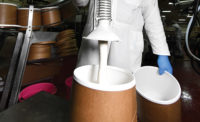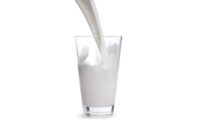Numerous processors of drinkable yogurts, other ready-to-drink (RTD) dairy beverages and RTD nondairy beverages rely on blow-molded bottles for their products. In many cases, these bottles are produced elsewhere and delivered to the processing facilities.
But dairy processors could reap a number of advantages by bringing blow-molding operations in-house.
Cost reductions and more
Alan Bonanno, marketing manager for Serac Inc., Carol Stream, Ill., notes that one of the most significant advantages to blowing bottles in house is cost savings.
“Raw materials can account for as much as 70 to 80% of a bottle’s cost,” said Bonanno, noting that bottles blown in-house can be lighter because they don’t undergo the initial stress and pressures associated with supplier shipping and subsequent storage. And less material eventually translates into transportation cost reductions for the finished product.
“Manufacturing in-house reduces the overall bottle weight while still creating a strong and rigid bottle that will meet all the shipping and handling requirements for transportation,” Bonanno said.
In-house blow-molding equipment also allows dairy processors to create differentiated packaging.
“As the number of new and specialty drinks increases, the need for unique packaging to match product branding increases,” said Steven Rocheleau, president of Rocheleau Tool & Die Co. Inc, Fitchburg, Mass. “While most blow molders want to focus on standard bottles to increase efficiency, marketing departments of the brand owners want to create unique packages with shelf appeal that sets them apart in a crowded marketplace.”
And dairy processors can tailor single-serve HDPE bottle systems for applications ranging from small-volume to high-volume, he added.
“In many cases, support equipment already in place for larger handled jugs can be tapped into to reduce upfront capital cost,” Rocheleau said, “or dedicated systems can be used to allow flexibility for pigmenting resin if required.”
In-house blow molding brings with it sterility advantages, too, even for small, single-serve containers, said David Skala, vice president of commercial business development for Uniloy, a brand of Cincinnati-headquartered Milacron LLC.
Recent advances
Equipment-related technology improvements also help make the case for bringing blow-molding operations in-house. Some of today’s equipment, for example, allows processors to create not only lighter-weight containers, but also unique shapes and sizes, Bonanno said.
“The Serac Combox SBL is able to blow mold containers as small as 50 milliliters and weighing less than 3 grams,” he noted. “This versatility allowed our customer to create a container for drinkable yogurt that was shaped like a strawberry and marketed as a nutritious and convenient lunchtime snack for children.”
The same machine can be combined with the company’s filling and capping machines, he added, allowing processors to produce, fill and cap bottles on a single machine.
Another recent advance is tied to aseptic blow molding of mono- and multi-layer containers, Skala noted. The sealed containers are processed in a filler equipped for the sterile removal of the seal within the filler.
Other noteworthy developments, he added, include “high cavitation of single-serve containers, up to 40 containers every six to seven seconds; multi-layer — three-layer on intermittent technology platforms, up to six on continuous extrusion technology platforms; all-electric machines for energy savings and, to a lesser extent, to remove hydraulic oil from the dairy processing operations; and the ability to extrusion blow mold PET, thus allowing for the opportunity to blow mold PET containers with integral handles.”
Uniloy’s capabilities mesh with the above advances, Skala noted, with the most significant being “commercialization of a machine capable of producing a range of high-cavitation, multi-layer, aseptic single-serve containers for the packaging of LSL dairy products.”
For its part, Sidel, (North American headquarters in Norcross, Ga.) recently received FDA approval for its advanced Aseptic Combi Predis FMa blow-fill-seal offering following test runs at a North American dairy customer facility. The first aseptic PET filling equipment with dry preform sterilization approved by FDA, the equipment now is validated for low-acid manufacturing and commercial distribution in the United States, the company noted.
Tread carefully
Before taking blow-molding operations in-house, processors should carefully consider their available options — and avoid some common mistakes. One such mistake is basing the buying decision solely on price, Skala said.
“The supplier has to provide dependable equipment that has a solid service support network,” he emphasized.
Another misstep could be buying blow-molding equipment from a supplier that does not fully understand the dairy processing industry, Skala said.
Buying a more sophisticated type of machine than needed for the job also is a common mistake, Bonanno said.
“The problem with some of these machines is the high level of support required to maintain this level of production,” he noted. “If the producer does not have the personnel with the skill set to operate and maintain the machines, the result will be high maintenance costs and frequent stoppages in production.”
Bonanno believes a dairy processor should assess the skill level of its employees as part of the decision-making process. In addition, it might want to invest in temporary consulting support when it comes to setting up processes and procedures for the new operation.
Finally, dairy beverage processors need to realize that in-house blow-molding operations aren’t a viable solution for every plant.
“The key is to understand the economics and to vet the opportunity to engage ‘through the wall’ opportunities — really understand what are the relative core competencies of the dairy itself and both factory and through-the-wall blow molders,” Skala said.







